Songs of Syx is a city-builder releasing now into Early Access. While full of potential in its vision of inter-city and imperial relations, the current implementation is little more than a generic city-builder.
Type: Single-player
Genre: Strategy, Management,
City-Building
Developer: Gamatron AB
Publisher: Gamatron AB
Release date: 21 Sept, 2020


Introduction
Songs of Syx, subtitled “An Epic City-State Simulator”, is a fantasy city-building game where you manage a single city (eventually with potentially different races and social classes) and (eventually) take after Rome and try to conquer the world to support your ever increasing, ever cozier, population. That is, until your elites start competing against each other while the barbarians bang at your door.
The former is mostly in place – although lacking in features, you can already see how the systems work and how new content easily fits in. You can satisfy your citizens’ basic needs and manage the supply chains to satisfy their more luxurious wants.
The latter is not implemented at all, beyond a very basic trading and (late game) taxing.
It’s certainly promising, but I’ll now go over the aspects I found most important.
At the moment, the most striking aspect of the game is its presentation. Although it has a very small resolution for its pixel art, the lighting gives it a unique look. I think it’s great.
The music is mostly background and not well developed just yet. The title track seemed straight out of Runescape or Daggerfall with its synthesized sounds (which I love, for some reason!), but most of the tracks are European folk songs in a neo-Celtic/Slavic style. They are very nice tracks, but few, and not conducive to the long play sessions of this kind of game. Easy to mute and play your own music, however.
The biggest problem is the interface, which has many problems due to a lack of play-testing. These should, of course, be solved in time, but be aware that the wiki is sparse (and sometimes has errors) and some of the elements of the interface can be buggy or misleading.
There are also visibility problem in the map (when trying to see which needs are filled or not, and so on) due to colors and size. But again, the game is just releasing into EA, so this is not too important.
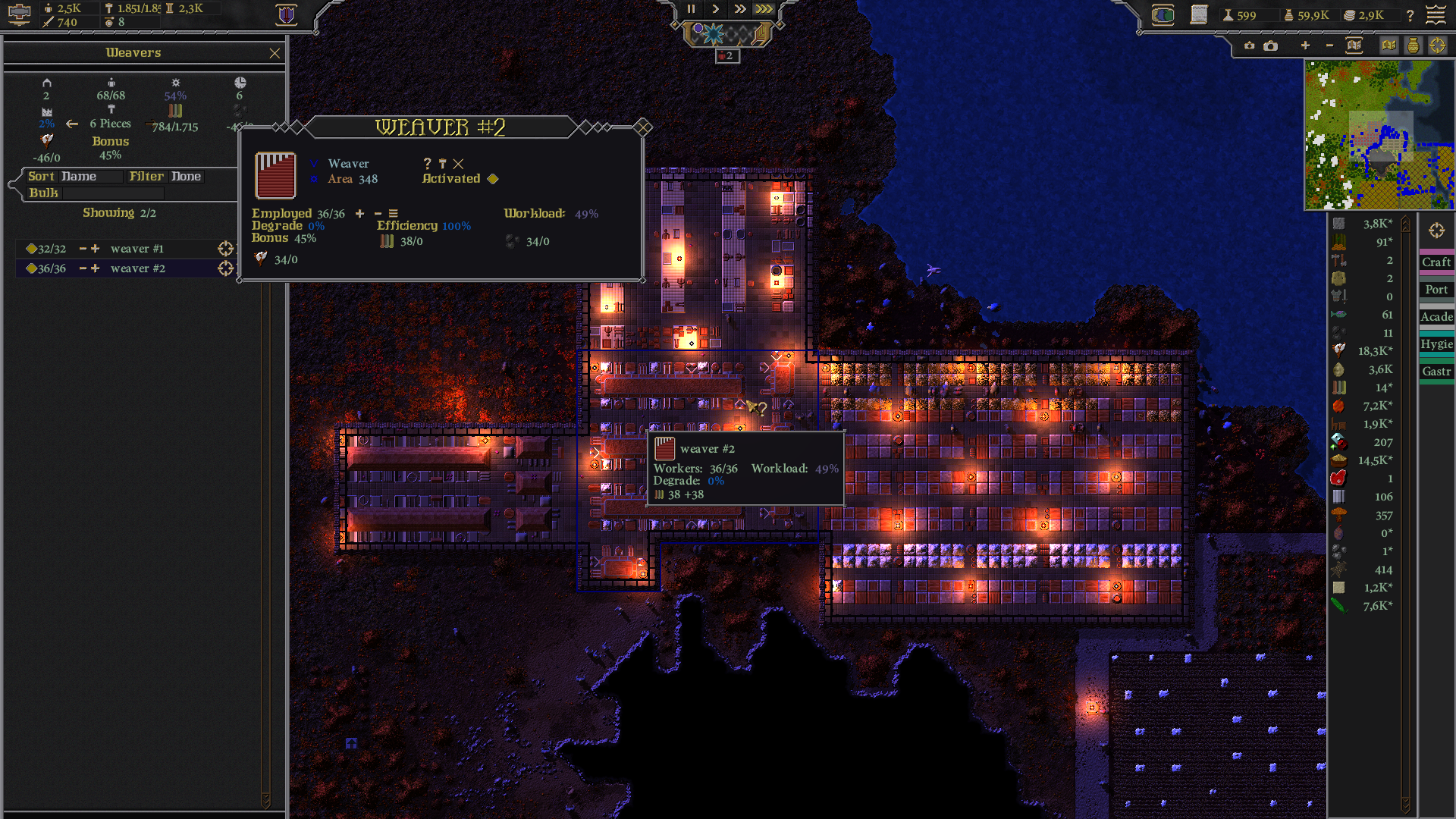
City-building Gameplay
The city-building, so far, is fairly standard fare. You have citizens, who have various needs (food, food variety, clothing, entertainment, bathing, light, awe, etc.) which you need to fulfill. Your city has a “reputation” score which determines the appeal of your city.
High appeal will attract immigrants (there is no reproduction for the dwarvish bearded hermaphrodites called Dondorians), increasing your resource pressures until the new equilibrium. Reputation is determined by the number of people in your city, multiplied by the various need meters.
The most crucial element, obviously, is food. The most important need is simply food *stores*, which are independent of the type of food and exist so that your citizens won’t go hungry. For their food preferences, you will need to increase variety by having grain, vegetables, mushrooms, fruits, fish, meat, eggs in their diet, as well as build kitchens and taverns.
Awe is a particularly interesting need – it’s basically about signaling the power and ideology of the empire to your citizens – by building statues over the city. I’ll write more about this in the “Mind” and “History” sections.
The construction of buildings is interesting, but not perfect just yet. Your buildings can have any size and shape, but you must then add furniture of various kinds to it – like a rectangular tetris puzzle. Some furniture types are simply about increasing the maximum number of workers, while others are about a “efficiency”. This is a multiplier (between 0 and 1) to its workers.
This can be a bit cumbersome when you have to cram some buildings into small spaces (and can’t just use the handy “copy tool”) and is currently a bit too simple – you simply add enough furniture for 100% efficiency and move on (but the act of adding furniture can be tedious and is not yet interesting).
You can also add custom buildings (which serve no specific professional purpose), but I didn’t find a use for these yet, beyond aesthetic role-play. Either way, this is one of the most unique aspects of the game, so far, and should be more clearly emphasized and developed!
Overall, the city-building aspect is functional, but basic. Variables need to be balanced – you can quickly exhaust stone supplies, but trees regenerate at a very fast rate, providing effectively infinite coal (a precious resource) through the charcoaler, who converts wood to coal.
There are occasional raids into your settlement (by a hoodlum named Krull), but these quickly lose interest. Military isn’t fully implemented yet and you have only infantry; plus the enemy only demands 25% of your resources (a tiny amount, in practical terms) and you can never defeat him permanently, so you’re better off ignoring him entirely.
The progression can also become a bit tedious – it’s okay at the beginning, but once you reach around 2k reputation (an important number for the Inter-city section), all you do is replicate the various buildings you already have to increase this number.
It will be interesting to see how the different races alter the basic city management as well as the different social classes. Alas, these were not yet in when I played the game.
In summary, the city-building is functional, but too monotonous. Once you’re past the very basic needs, managing a big or a huge population doesn’t seem qualitatively different. This is, of course, subject to change when you can interact with neighboring systems more deeply.
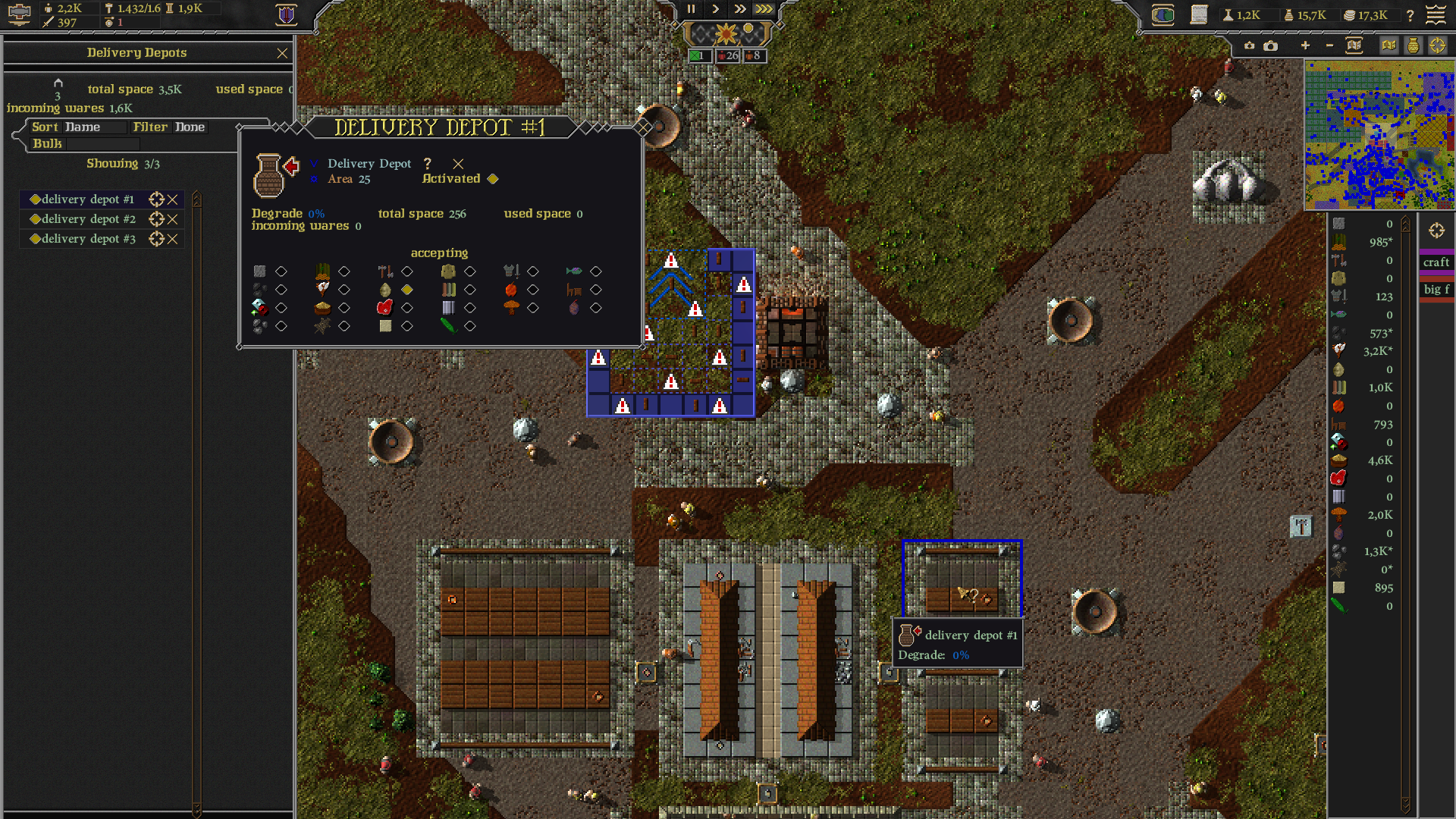
Inter-city Gameplay
This is the most promising aspect of the game. It’s what will set it apart from just about every other city-builder. Unfortunately, it is too barebones, for now – too barebones to even judge whether or not the design will work.
Currently, there are two things you can do: trade, and conquer/tax. The latter is mostly symbolic, though, and not yet a “real” mechanic.
To export, you build a trading depot and set whichever resources you are accepting. Then you go into the resource panel and select the resource to import when your stores are above a certain %. To import, you build an Import Depot and do the same, except you select to import when your stores are below a certain %.
The system is supposed to be easy to use and automatic, selecting the lowest seller and sending a caravan your way. Unfortunately, it is far too opaque – and it also happened to be buggy when I attempted to use it, so it wasn’t anything I spent too long messing with. At least one of the bugs I experienced was solved, but I still wouldn’t characterize the system as “easy to use”. It’s difficult to see how much you’re selling and buying at a glance, since the various plots are represented by unnumbered bars buried inside the resource panel. The game doesn’t yet have the tools to really convey all the necessary information.
To tax, you need to have a Might of at least 2k. For now, Might is the same as Reputation, though I suppose it will be modified by other variables in the future. You can tax your home region once you reach 2k Might, and you can conquer one different region as well. “Conquering” simply means pressing the “claim” button on the region. To tax a second region, you need a Might of 4k.
Taxing is basically “free imports”, at least for now, but it is dependent on the region’s available resources.
This is it for inter-city gameplay. It is very little and not at all a game changer just yet. Moreover, getting 2k Reputation is already a fairly long process, and it uses up all of the game’s city-management mechanics. Trying to go all the way up to 4k seemed too big of a leap, to me, especially for the negligible reward.
Now, onto two important aspects in which I found the game somewhat lacking. One has to do with the particular tasks you’re actually involved in, as a player; the other has to do with historical flavor.
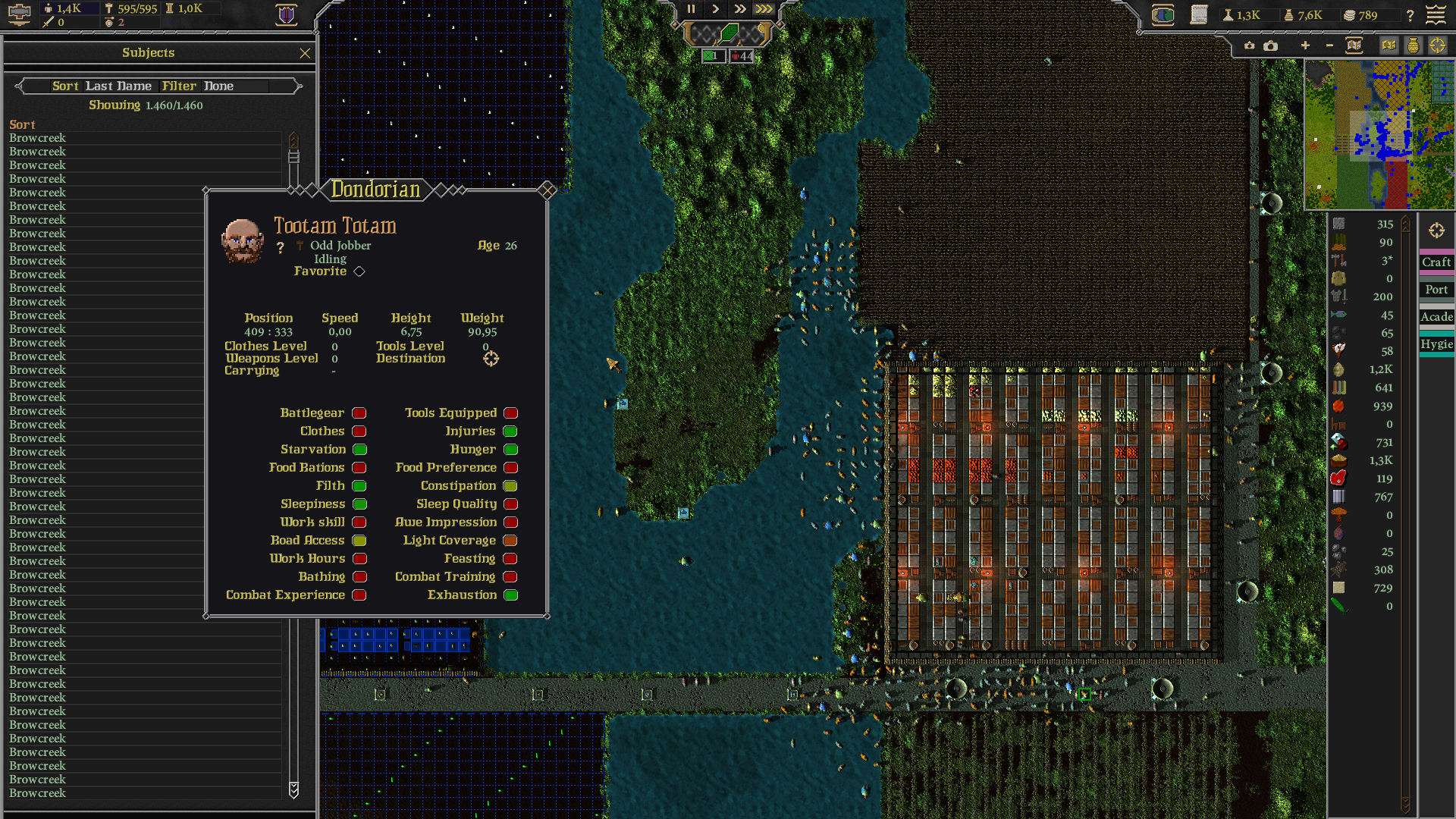
Mechanics in the Mind
The biggest problem I had with the game, in its current state, is that you don’t feel like a ruler in charge of a city. While planning the city and the various supplies is a big part of the game, it seems that I have spend much longer worrying about where to place the torches (to maximize the “light” need) and monuments along roads (to maximize “awe”) as well as placing dozens or hundreds of rugs in rooms (to maximize efficiency, coziness, or whatever).
Too much time is spent in petty and trivial tasks because of the way that the game is built.
I think this has two causes:
(1) The resource interface isn’t clear nor easy to use. The histograms, especially, being unnumbered, make it very difficult to know how much of a resource is actually being consumed, by whom, and so on. This means that you can’t do fine-grained optimization of the supplies. I found myself just “building big” and moving on.
(2) The complexity mismatches the vision. It seems, to me, that the game tries to add complexity through a “deep simulation” (where you have individual agents doing tasks instead of having buildings operating themselves and affecting the numbers directly), but the complexity ends up being contained in the least interest areas of the game. It disperses attention from what matters instead of focusing it.
This is, of course, subject to change, but it is how I felt after I learned the basics and started my city anew. Perhaps matters will be different once there are different classes and races that will require you to react to different needs at different times. Right now, you basically place all of the buildings in a more or less fixed order and spend most of the time worrying about minor minutia of furniture and torch placement.
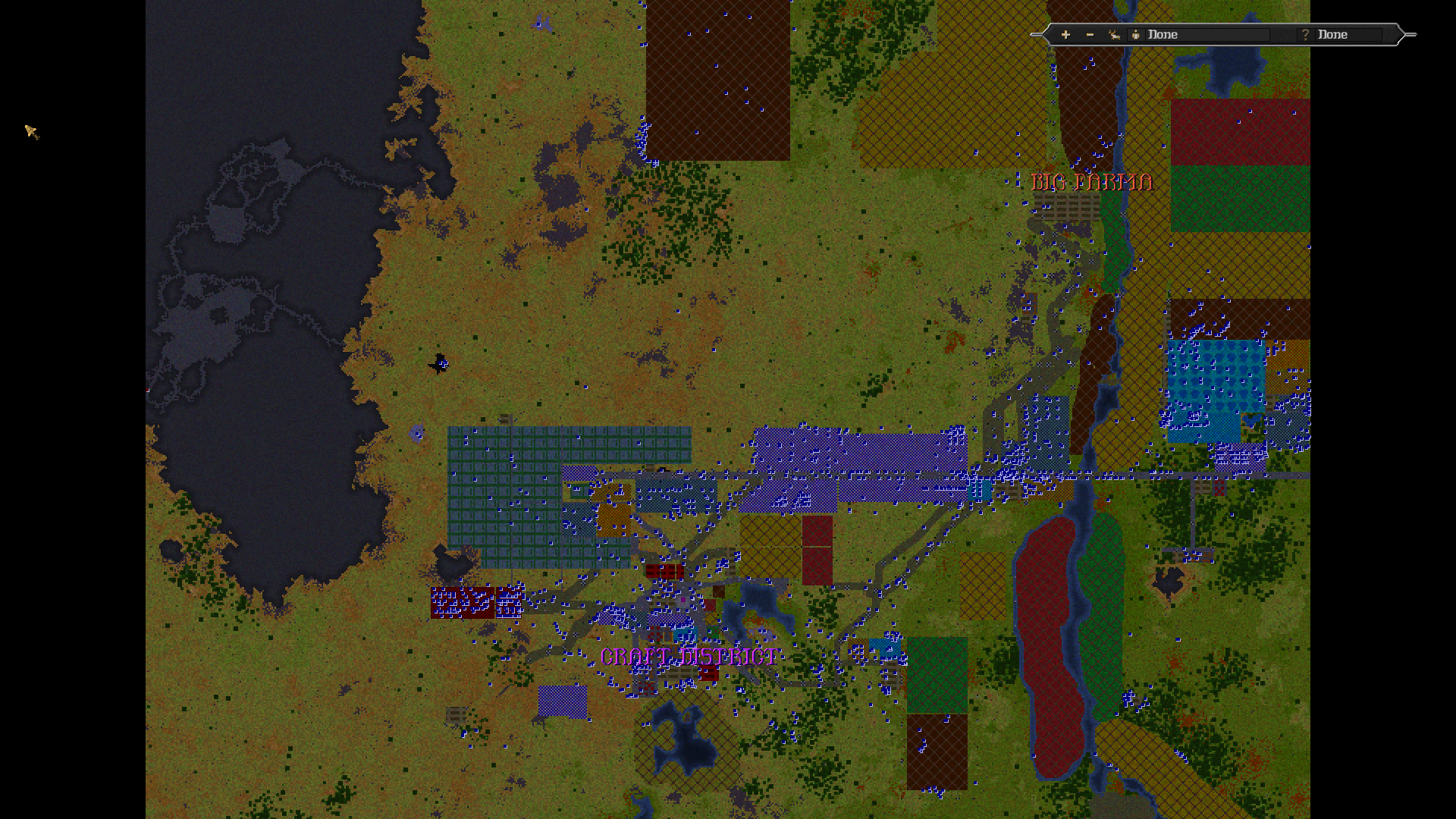
Mechanics and History
This is a second fairly big problem I had with the game, if somewhat nit-picky. When I say “History” I don’t mean it in too particular of a way of time periods and technology, but of general flavor.
The first example is the way “Awe” works. Awe is a want of your citizens tied to their exposure to trees and statues as they go throughout their day. Once you place a statue, it affects citizens that pass within a certain radius of it.
Unfortunately, while symbolic “propaganda” is very much a part of history, the current implementation lacks all the flavor – which also relates the previous section.
For example, Rome had its Triumphal Arches, marking conquered towns and showing its power. This is typically one big and powerful monument. What Songs of Syx implements, is 500 triumphal arches 20 meters apart along roads. For me, it loses all the appeal.
Another example, especially in the context of city-states, is Sumeria with its huge temples and Ziggurats, or the Maya.
I feel like the whole Awe mechanic is just another petty task with little flavor, and one where flavor is readily available in the real world! Construct huge temples (this could be one purpose for the custom buildings) or periodically organize costly festivals. Anything but placing hundreds of tiny objects with little overall impact (and little readability).
Another example comes from research. Basically, you construct a big library, which accumulates “knowledge” points and that’s it. A library is both an engine to create knowledge, and a storehouse for it. The number of workers determines how fast the engine runs, its size how much knowledge it can store.
But this also lacks any historical flavor and is too simplistic of a system.
This one is more liable to change, since the developer mentioned having “outside visitors” at some point, who are also knowledge carriers. But, as is, it feels very barebones and unsatisfying.
To conclude, the point is that the game lacks historical flavor. Many systems point to history, very generally, but fails to color the picture despite the readily available ink.
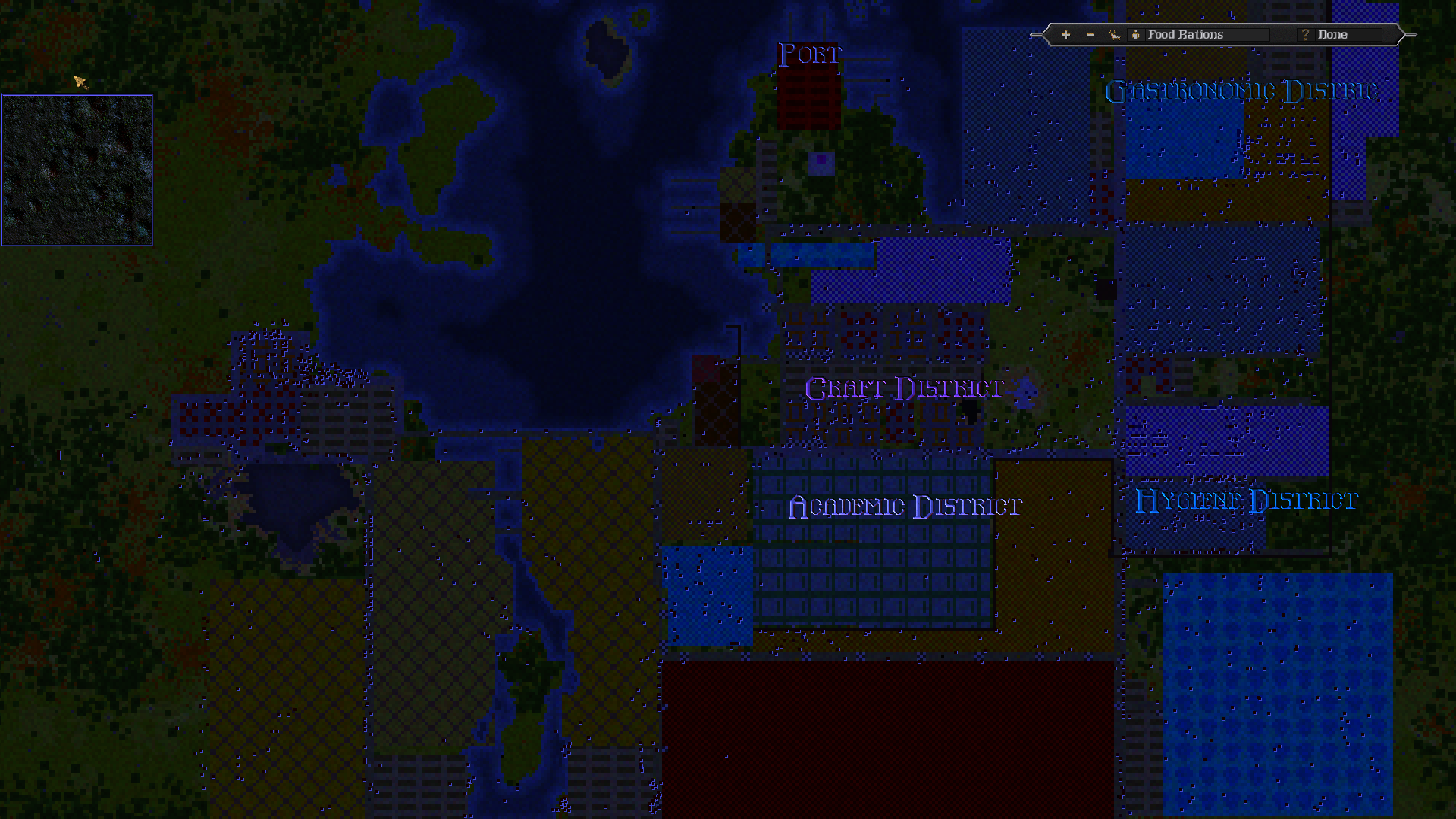
Conclusion
Songs of Syx is very promising. Although its development time of years promises a long time in incubation in Early Access, you can see that the city-level groundwork has been implemented. Although missing many features, the wiki and modding tools are functional and ready for more specific content to be implemented.
More problematic are the inter-city mechanics, which are in too primitive a shape. This is also the most interesting aspect of the game, at least in potential, but, being the most unique, will be the toughest to design; it is too early to say whether or not the game will satisfy its boldest vision.
Honestly, I enjoyed my time with it, so far, and am looking forward to coming back to it later down the line (months? years?). I also enjoyed learning the mechanics, although it required a healthy dose of clarification in the Discord.
At the moment, however, it has little more than vision (and the very large number of agents and map size!) to distinguish itself from other games in the genre (and adjacent genres).
I’d definitely recommend keeping an eye on the game, but I’d warn whoever wants to *play* the Early Access version that, as it stands, this is a fairly generic and barebones city-building game – its soul has not yet been breathed into the game.
Bonus
If you’re interested in playing Songs of Syx you may be in luck! Ask JimDeadlock on our Discord server and he may have a free key for you, if you’re quick! All gone!










